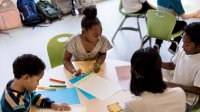3 Activities That Guide Every Student to Contribute in Class
Asset-based teaching starts from the idea that every student has something to share, and these activities get everyone talking.
Your content has been saved!
Go to My Saved Content.As educators, our goal should be to create initiative taking and lifelong learners who are independent, embrace challenge, and value effort as a path to proficiency. How can we create such learners? By cultivating high expectations and the belief that every student can be successful.
Asset-based pedagogy means planning with students’ strengths at the forefront. Every student has something to learn, share, and contribute. When proactively planning for instructional opportunities, asset-based teachers provide multiple access points for success, present a variety of modality choices, and promote a positive climate for students to learn from each other. The strategies that follow can support you in asset-based teaching activity planning.
Bounce Cards
Bounce cards provide students with a purposeful way to build a cooperative learning classroom environment. In elementary school, young learners are developing awareness of themselves and others; thus, activities that promote active listening, turn-taking, and perspective sharing are essential to building healthy, long-lasting team behaviors. In this activity, students choose topics for classroom conversation and plan how to discuss them in a variety of ways.
To start, select a student with whom to practice modeling a conversation. Practice with that student before modeling for the class. Then, in front of the class, model the inappropriate way to hold a conversation. For example, demonstrate a conversation that ends quickly once both parties have shared their responses, without a back-and-forth exchange or extended dialogue. Next, discuss as a class the importance of conversational skills that allow ideas to bounce from one person to the next. Then, discuss the following three approaches that students can use to respond to one another’s comments during a conversation.
Bounce: Bounce an idea off what a peer said or elaborate on it. Ask students to use starters such as “That reminds me of...,” “I agree because...,” “True, and another example is when...,” or “That’s a great point.”
Sum it up: Rephrase what a peer said and comment on certain parts. Students can start their comments with “I hear you saying that...,” “So if I understand you correctly...,” or “I like how you said...”.
Inquire: Ask a question. Encourage student peers to use prompts such as “Can you tell me more about that?” or “I’m not sure I understand.” Try other prompts too, including “I see your point, but what about...?” or “Have you thought about…?”
See, Think, Wonder
See, Think, Wonder is a thinking-made-visible routine created by Project Zero. Its goal is to stimulate curiosity, normalize error, increase critical thinking skills, and allow for every learner to start from a place of success. To start, provide students with a three-column organizer, with the columns titled, “See,” “Think,” and “Wonder.” A useful template is available at Thinking Pathways. Next, show students a stimulating image. Select captivating images that will solicit conversation, which will get students excited, and activate background knowledge. Allow students time to brainstorm and write their responses. Then, follow the steps below.
- Model for the class sharing aloud reactions and responses, using the protocol.
- After a few minutes, invite students to choose something they would like to share with a partner. Tell students they can choose which of the three questions they would like to share with a peer. This allows a student to choose whether to share a “See,” “Think,” or “Wonder” with their partner.
- After they talk with a peer, ask students to volunteer to share with the whole class what they recorded from any of their three columns.
- The teacher collects information shared from students and visibly records class responses on an anchor chart, Google Doc, or whiteboard for the class to view. The information collected can be used to support further discussion and inquiry, subsequent instruction, and assessment.
Which One Doesn’t Belong?
This analytic thinking exercise requires students to compare similarities and differences, but in a fun way like Sesame Street’s “One of these things is not like the others” activity. It is a reasoning activity geared toward students’ practicing their reasoning skills and sharing their thought processes with others. All students can participate and feel comfortable taking a risk because there is no wrong answer. Which One Doesn’t Belong? is a great instructional activity for math classrooms, eliciting discussion and allowing every student the opportunity to share their thinking.
First, choose a group of three or four images (graphs, equations, numbers, etc.) connected with your math standard, objective, or essential question. Next, provide students with time to ponder. For advanced mathematical inquiry, accelerate learning by asking students to produce reasons why each item doesn’t belong. Provide conversation stems, such as, “I agree/disagree with _____ because,” and encourage students to share with a partner.
Circulate around the classroom to listen to student discussion and collect data. Listen and observe for such things as the academic language used, the skills that students exhibit, and task-related data you can use to differentiate math instruction going forward. Visit the Which One Doesn’t Belong? website for hundreds of options aligned to mathematical standards at every grade level.
An asset-based approach to pedagogy means being intentional about getting to know our students as learners and building with them an engaging community. As educators, we best serve our students when we support them in becoming curious analytical problem solvers who are conversant in divergent ideas and embrace discussing different perspectives.
